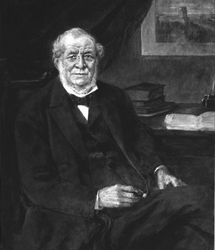Robert Wilhelm Bunsen

13-03-1811: 16-08-1899
Born in :Gottingen, Germany
Areas of Research :
- Spectroscopy
- Bunsen Burner
- Geology
- Discovery of Cesium, Rubidium
|
Robert Wilhelm Bunsen was born in Gottingen, Germany was the youngest of the four sons. His father was Chief librarian and Professor in the University of Gottingen. He did poineering work in organic Chemistry. With his assistant, Peter Desaga, developed the Bunsen burner and he is more popular for this invention. Bunsen was an experimentalist rather than a thereotician and also popular as a teacher. He worked with organic compounds containing arsenic, almost poisoning himself to the point of death. At an young age, while researching in his lab a compound exploded and as a result he lost one of his eyes. Inspite of his ill health and loss of part vision he did extraordinary amount of research in different fields till the age of 88.
Bunsen was one of the most admired scientists of his generation. He was a master teacher, devoted to his students, and they were equally devoted to him. At a time of vigorous and often caustic scientific debates, Bunsen always conducted himself as a perfect gentleman, maintaining his distance from theoretical disputes.
Along with Gustav Robert Kirchhoff, Bunsen was responsible for developing the field of Spectrometry. He investigated emission spectra of heated elements, discovered Cesium (in 1860) and Rubidium (in 1861). Bunsen developed several gas-analytical methods and was a pioneer in photochemistry.
His other achievements are developing the efficiency of the working of blast furnace in Germany and Britain. During the working of the furnace he observed that a lot of heat was being dissipated to the surroundings. With the collaboration, Lyon Playfair, he devised a technique of recycling the heat (heat exchangers), thus increasing its efficiency. He invented a carbon electrode to improve batteries in use at that time, also found a use of iron oxide hydrate as an antidote for arsenic poisoning.
In 1860, he was elected as a foreign member of the Royal Swedish Academy Of Sciences. And used electrolysis to produce pure metals, such as Chromium, barium, magnesium, manganese, sodium, aluminium, calcium and lithium.
Source: Asimov on Chemistry and the internet |